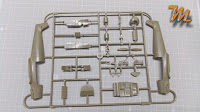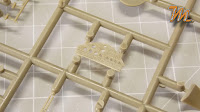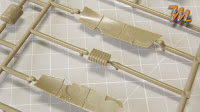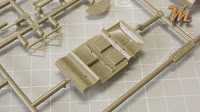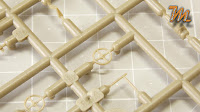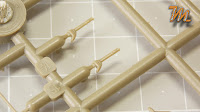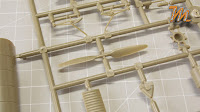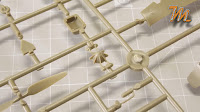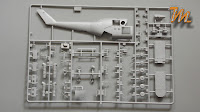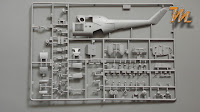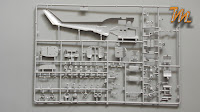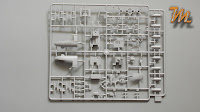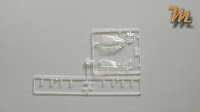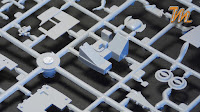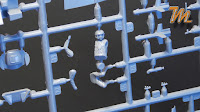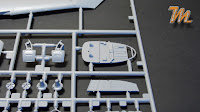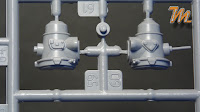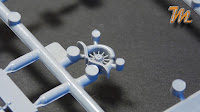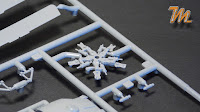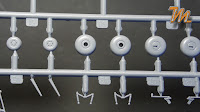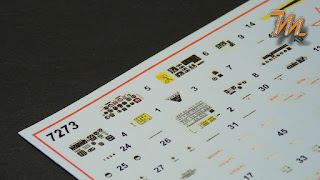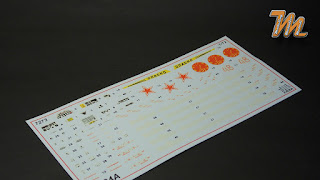Messerschmitt Bf-108B
Eduard 1/48, kit 8054 - inbox review
History
The BWF Company (latter Messerschmitt A.G.) designed the Messerschmitt Bf-108 Taifun in 1934. The original design was for a light tourist
double seater, developed for the German team taking part in the 1934 international air race Challenge.
The military version of the Taifun was the Bf-108B-2 and was acquired by the Luftwaffe in 1939. It was widely employed during the war years by all operational Luftwaffe units as a light liaison aircraft.
In 1941 the new version, the Messerschmitt Bf-108D, replaced the B version on the production line. An Argus As 10R engine powered the D version and included the new Argus automatically adjustable propeller and improved fuel assembly. The production was transferred to France in 1942, where 170 Bf-108D were completed before the liberation of France in 1944. French production continued after the war where another 115 aircraft under the name of "Nord 1000" were manufactured. In total 626 military Taifuns, versions B-2 and D-1, were produced except at least 180 civilian or export version Bf-108 B-0 and B-1.
The Luftwaffe employed most of them, but many other air forces used this fine and popular aircraft. The Hungarian AF had 8 Taifuns, both the Italians and Rumanians had 3, the USSR bought two and Switzerland and Yugoslavia had 12 each. One aircraft was used in Chile, one or two in Japan and one was in Australia. The Bulgarian AF had 6 and at least one was in Spain. One Bf-108B-1, coded XC44, was operated by the US embassy in Berlin. Two Bf-108B-1s were flown by the German embassy in London but the RAF confiscated these two aircraft in 1939.After the war, one Bf- 108B-2 was flown in Czechoslovakia, two in Poland, one in Denmark and one in Sweden. Some 115 Bf-108Ds ( Nord 1000) were used by the French AF and Navy until the late 50's.
Many of the surviving Taifuns were flown a long time after the war, and some of them are still in airworthy condition today
Source: the instructions
The military version of the Taifun was the Bf-108B-2 and was acquired by the Luftwaffe in 1939. It was widely employed during the war years by all operational Luftwaffe units as a light liaison aircraft.
In 1941 the new version, the Messerschmitt Bf-108D, replaced the B version on the production line. An Argus As 10R engine powered the D version and included the new Argus automatically adjustable propeller and improved fuel assembly. The production was transferred to France in 1942, where 170 Bf-108D were completed before the liberation of France in 1944. French production continued after the war where another 115 aircraft under the name of "Nord 1000" were manufactured. In total 626 military Taifuns, versions B-2 and D-1, were produced except at least 180 civilian or export version Bf-108 B-0 and B-1.
The Luftwaffe employed most of them, but many other air forces used this fine and popular aircraft. The Hungarian AF had 8 Taifuns, both the Italians and Rumanians had 3, the USSR bought two and Switzerland and Yugoslavia had 12 each. One aircraft was used in Chile, one or two in Japan and one was in Australia. The Bulgarian AF had 6 and at least one was in Spain. One Bf-108B-1, coded XC44, was operated by the US embassy in Berlin. Two Bf-108B-1s were flown by the German embassy in London but the RAF confiscated these two aircraft in 1939.After the war, one Bf- 108B-2 was flown in Czechoslovakia, two in Poland, one in Denmark and one in Sweden. Some 115 Bf-108Ds ( Nord 1000) were used by the French AF and Navy until the late 50's.
Many of the surviving Taifuns were flown a long time after the war, and some of them are still in airworthy condition today
Source: the instructions
Inside the Box
The Messerschmitt Bf-108B kit from Eduard comes in top opening box with dramatic boxart depicting Yugoslavian Bf-108 in the middle of dogfight between Yugoslavian ant Luftwaffe Bf-109s. This issue, with kit number 8054, came in 2009 and its a rebox of the 2002 initial release. The kit is Profi Pack so it comes with some goodies - photo etched set and die-cut masks.
Inside the box there are three olive colored plastic sprues (on one of which I don't have pictures) , one transparent sprue, photo-etch fret, decal sheet, die-cut masks and the instructions. The Instructions are typical for Eduard, clear and easy to follow. Just pay attention to the options.
a - Yugoslav Air Force, Kraljevo, 1940
b - Sonderkommando Blaich, Libya 1942
c - 4.(H)/13, Rumania, 1940
d - Flugbereitschaft Luftflotte 4, 1941
e - I./JG27, Innsbruck 1941
Marking options
Out of the box there are five marking options available:a - Yugoslav Air Force, Kraljevo, 1940
b - Sonderkommando Blaich, Libya 1942
c - 4.(H)/13, Rumania, 1940
d - Flugbereitschaft Luftflotte 4, 1941
e - I./JG27, Innsbruck 1941
Closer Inspection
The quality of that plastic scale model kit is very close to today's standards of the company despite the initial release being from the beginning of the century. There is some minor flash evident but noting that cannot be dealt with for a few seconds. Yes, the panel lines are a bit over pronounced but still crisp and consistent.
Bf-108B - Cockpit
The cockpit of the scale model is mainly situated on sprue A and the photo Etched fret. Quite a lot of part go in that area. Along with the plastic there are the comprehensive PE details for the seat belts, knobs, trim wheel chains etc. The seats look really good and if you decide to go with marking option B you'll have to replace the full rear bench with half bench and two cylindrical containers. You can choose from three instrument panel types. One from the PE set, and two from the plastic sprues. One of them has the instrument faces molded in and the other has holes instead so you can add decals behind the detail... only thing is that there are no such decals in the Profi Pack kit.
The quality of that plastic scale model kit is very close to today's standards of the company despite the initial release being from the beginning of the century. There is some minor flash evident but noting that cannot be dealt with for a few seconds. Yes, the panel lines are a bit over pronounced but still crisp and consistent.
Bf-108B - Cockpit
The cockpit of the scale model is mainly situated on sprue A and the photo Etched fret. Quite a lot of part go in that area. Along with the plastic there are the comprehensive PE details for the seat belts, knobs, trim wheel chains etc. The seats look really good and if you decide to go with marking option B you'll have to replace the full rear bench with half bench and two cylindrical containers. You can choose from three instrument panel types. One from the PE set, and two from the plastic sprues. One of them has the instrument faces molded in and the other has holes instead so you can add decals behind the detail... only thing is that there are no such decals in the Profi Pack kit.
Bf-108B - Engine and propeller
The engine is very well detailed as well. The engine block is made of two pieces, and the cylinders come as separate pieces as well as the push rods. There are also engine block cover, exhaust pipes , crank case and mounting structure. The weird thing is that the hatches on the cowling are not meant to be opened and the engine will only be visible from the front air inlet.
Bf-108B - Wings and fuselage
The wings are made of two upper halves and one lower part. The fuselage is split in two, lengthwise. The tip of the cowling is a separate part. There are two rudder types provided, one of them to be used with marking option B. The control surfaces have nice ribbing detail molded in. As I have written previously, the panel lines are not so delicate as on Eduard's more recent kits but are still excellent.

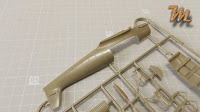

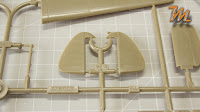
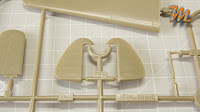

Bf-108B - Canopy.
On the clear sprue there are a total of 2 parts. One is some landing light and the other - the canopy of the scale model. It seems to be very decent one, the frames are fine and look true to scale. Transparency also leaves the impression of very high quality product. Only thing that I dont like is the fact that the canopy is in one piece and it will be quite a surgery to open those big doors.
On the clear sprue there are a total of 2 parts. One is some landing light and the other - the canopy of the scale model. It seems to be very decent one, the frames are fine and look true to scale. Transparency also leaves the impression of very high quality product. Only thing that I dont like is the fact that the canopy is in one piece and it will be quite a surgery to open those big doors.
Bf-108B - Undercarriage
The real aircraft have quite simple gear system, two outward closing front legs and a fixed rear wheel. The wheels look decent as well as the gear doors. There are PE brake lines and oleo scissors to help spice this area up.
Bf-108B - Photo etched details
The details on the photo etched fret are focused on the interior but there are a few bits and pieces that are meant to go on other areas. This PE is pre-colored and is produced in the usual high standard and will greatly boost the level of detail of your scale model.

Bf-108B - Decals
The decals look well made and everything seems to be in register. From what I can recall, building Eduard kits, the decals behave nicely and are trouble free.
Bf-108B - Conclusion.
The Messerschmitt Bf-108B kit have very impressive quality, if its possible to judge this by only looking at the sprues. There are plenty of details so the scale model can be very impressive even built OOB. The photo etched parts might be a challenge to some of the less experienced modelers but other than that I highly recommend this kit.
Best regards and happy modeling
Metodi Metodiev
25.01.2016




